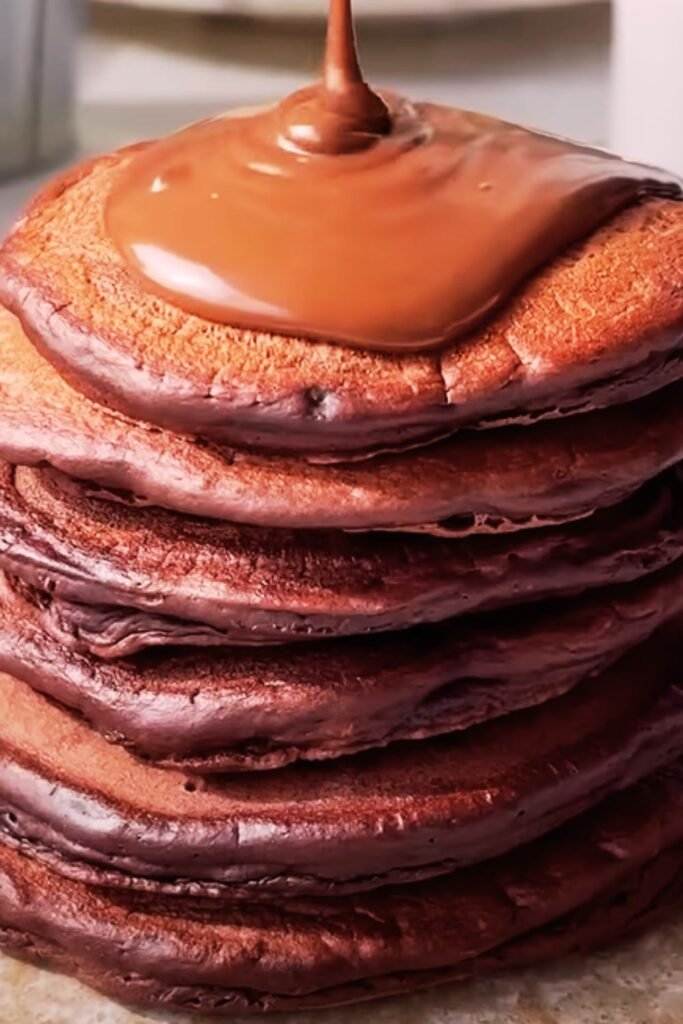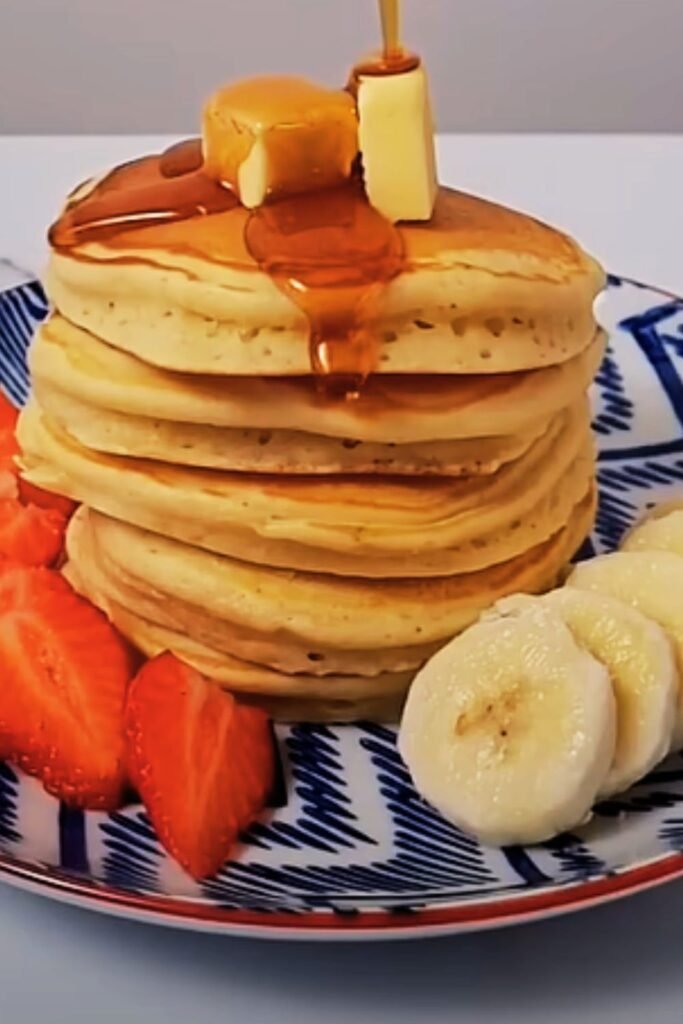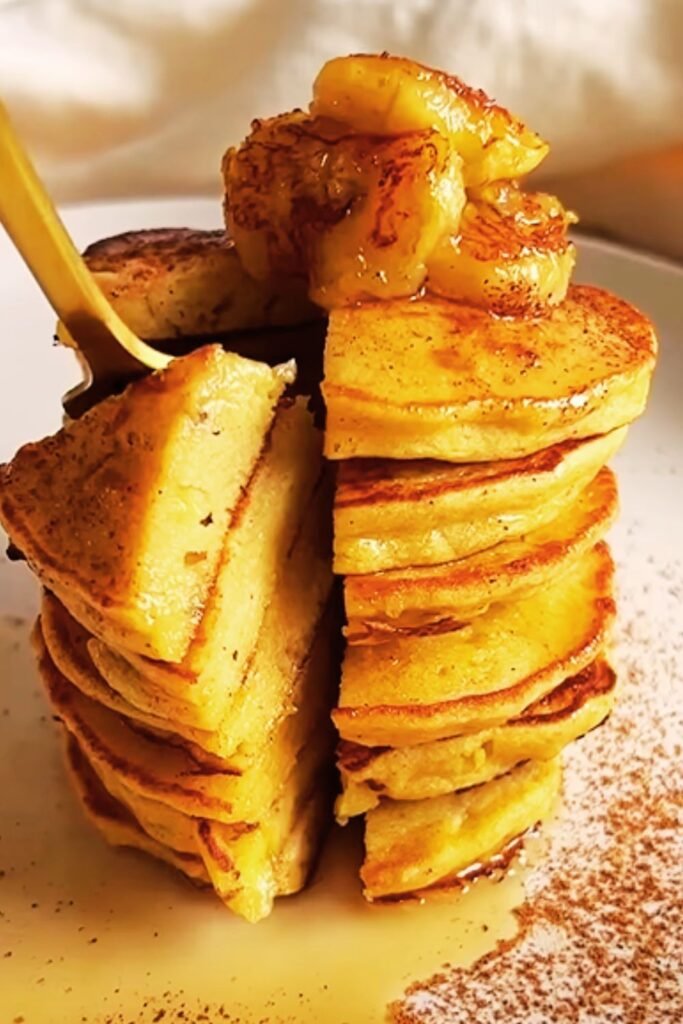There’s something magical about waking up to the smell of pancakes sizzling on a hot griddle. I’ve spent years perfecting my pancake recipe, and today I’m sharing all my secrets for creating the fluffiest, most delicious homemade pancakes you’ve ever tasted. This isn’t just another pancake recipe—it’s a comprehensive guide that will transform your breakfast game forever.
The Magic of Homemade Pancakes
I still remember my grandmother’s kitchen on Sunday mornings—the warm aroma of butter melting on the griddle, the sound of batter hitting the hot surface, and the excitement of watching pancakes puff up to golden perfection. Store-bought mixes simply can’t compare to pancakes made from scratch.
When I make pancakes at home, I’m not just cooking breakfast; I’m creating memories. The process is therapeutic, and the results are infinitely customizable. Whether you prefer classic buttermilk pancakes, hearty whole grain versions, or something studded with fresh fruit, this guide will help you master the art of pancake-making.
Essential Ingredients for Perfect Pancakes
The beauty of pancakes lies in their simplicity. With just a handful of pantry staples, you can create something truly exceptional.
All-Purpose Flour
The foundation of most pancake recipes. I prefer unbleached all-purpose flour for its neutral flavor and reliable performance. For health-conscious folks, you can substitute up to half with whole wheat flour without sacrificing too much fluffiness.
Leavening Agents
Baking powder is the secret to fluffy pancakes. Fresh baking powder is crucial—if yours has been sitting in the pantry for over six months, it’s time for a replacement. Some recipes also include a touch of baking soda, especially when paired with acidic ingredients like buttermilk.
Sweeteners
I typically use regular granulated sugar, but honey, maple syrup, or brown sugar can add wonderful flavor dimensions. The pancakes shouldn’t be overly sweet—you’ll add more sweetness with toppings.
Salt
Don’t skip this! Even a small amount enhances all the other flavors and prevents pancakes from tasting flat.
Eggs
They provide structure, richness, and help bind everything together. Room-temperature eggs incorporate more easily into your batter.
Milk or Buttermilk
The liquid component creates the batter’s consistency. Buttermilk produces tangy, tender pancakes, while regular milk works perfectly for classic versions. Plant-based milks can be substituted with minor adjustments.
Fat
Melted butter adds incomparable flavor, but neutral oils like canola or vegetable oil work well too. Don’t skimp here—fat contributes to moisture and tenderness.
Flavor Enhancers
Vanilla extract is my go-to, but don’t stop there! Cinnamon, nutmeg, citrus zest, or almond extract can transform a basic recipe into something special.
The Ultimate Pancake Recipe
After countless Sunday mornings experimenting, I’ve developed what I believe is the perfect basic pancake recipe. It creates light, fluffy pancakes with a tender crumb and just the right amount of sweetness.
Ingredients
- 2 cups (250g) all-purpose flour
- 3 tablespoons granulated sugar
- 2½ teaspoons baking powder
- ½ teaspoon baking soda
- ½ teaspoon salt
- 2 large eggs, room temperature
- 1¾ cups buttermilk (or regular milk with 1½ tablespoons lemon juice added)
- ¼ cup (57g) unsalted butter, melted and slightly cooled
- 2 teaspoons pure vanilla extract
- Extra butter or oil for the griddle/pan
Step-by-Step Instructions
- Combine dry ingredients – In a large bowl, whisk together flour, sugar, baking powder, baking soda, and salt until well combined.
- Mix wet ingredients – In a separate bowl, whisk eggs until frothy, then add buttermilk, melted butter, and vanilla. Whisk until smooth.
- Combine wet and dry – Pour wet ingredients into dry ingredients. Using a wooden spoon or rubber spatula, gently fold the mixture together until just combined. Some small lumps are good—overmixing is the enemy of fluffy pancakes!
- Rest the batter – Let the batter rest for 10-15 minutes. This allows the gluten to relax and the leavening agents to activate, resulting in more tender, fluffier pancakes.
- Prepare your cooking surface – Heat a griddle or non-stick pan over medium heat. When a few drops of water dance and evaporate immediately on the surface, it’s ready. Lightly brush with butter or oil.
- Cook the pancakes – For each pancake, pour about ¼ cup of batter onto the hot surface. Cook until bubbles form on the surface and the edges look set (about 2-3 minutes).
- Flip with confidence – In one decisive motion, slide a thin spatula under the pancake and flip. Cook until the second side is golden brown (about 1-2 minutes more).
- Keep warm – Transfer cooked pancakes to a baking sheet in a 200°F (95°C) oven to keep warm while cooking the remaining batter.

The Science Behind Perfect Pancakes
Understanding the science of pancake-making can elevate your breakfast game from good to extraordinary. Here’s what’s happening in your mixing bowl and on your griddle:
Gluten Development
When flour meets liquid, gluten proteins form. Too much gluten development makes tough pancakes, which is why we:
- Mix the batter gently
- Leave lumps in the batter
- Let the batter rest before cooking
Leavening Action
The magic of fluffy pancakes comes from:
- Baking powder releasing carbon dioxide when heated
- Baking soda reacting with acidic ingredients (like buttermilk)
- Air incorporated during mixing
- Steam created during cooking
Maillard Reaction
That beautiful golden-brown color and complex flavor comes from the Maillard reaction—a chemical reaction between amino acids and reducing sugars that occurs when cooking at higher temperatures.
Pancake Troubleshooting Guide
Even experienced cooks sometimes encounter pancake problems. Here’s how to fix the most common issues:
| Problem | Possible Cause | Solution |
|---|---|---|
| Pancakes are flat/dense | Old leavening agents<br>Overmixed batter<br>Too little leavening | Replace baking powder/soda<br>Mix just until combined<br>Check measurements |
| Pancakes are pale | Pan not hot enough<br>Too little sugar | Increase heat<br>Add a bit more sugar |
| Pancakes burn before cooking through | Heat too high<br>Pan too thin | Lower heat<br>Use heavier pan |
| Batter is too thick | Too much flour<br>Too little liquid | Add milk, 1 tablespoon at a time<br>Check measurements |
| Batter is too thin | Too much liquid<br>Too little flour | Add flour, 1 tablespoon at a time<br>Let batter rest longer |
| Uneven cooking | Uneven heat distribution<br>Pan/griddle not level | Use quality cookware<br>Check level of cooking surface |
| Pancakes stick to pan | Too little fat<br>Pan not hot enough<br>Non-stick surface worn | Add more butter/oil<br>Wait until pan is properly heated<br>Replace cookware |
Pancake Variations to Try
Once you’ve mastered the basic recipe, why not experiment with these delicious variations?
Blueberry Pancakes
Fold 1 cup fresh or frozen blueberries (if frozen, don’t thaw) into the batter just before cooking. Alternatively, sprinkle berries onto each pancake immediately after pouring the batter onto the griddle.
Banana Nut Pancakes
Add ½ cup mashed ripe banana and ½ teaspoon cinnamon to the wet ingredients. Fold ⅓ cup chopped toasted walnuts or pecans into the finished batter.
Chocolate Chip Pancakes
Fold ½ cup chocolate chips into the batter. Use mini chips for more even distribution.
Whole Grain Pancakes
Replace half the all-purpose flour with whole wheat flour. Add an extra tablespoon of milk if the batter seems too thick.
Lemon Ricotta Pancakes
Add ¾ cup ricotta cheese, 1 tablespoon lemon zest, and 1 tablespoon lemon juice to the wet ingredients for incredibly tender, bright-flavored pancakes.
Pumpkin Spice Pancakes
Replace ½ cup of buttermilk with ½ cup pumpkin puree and add 1½ teaspoons pumpkin pie spice to the dry ingredients.
Apple Cinnamon Pancakes
Fold in 1 cup grated apple (about 1 medium apple) and 1 teaspoon cinnamon. These taste like apple pie for breakfast!
Cornmeal Pancakes
Replace ½ cup of the all-purpose flour with fine cornmeal for pancakes with a subtle crunch and lovely yellow hue.

The Ultimate Pancake Toppings Guide
While maple syrup is the classic choice, don’t limit yourself! Here’s a comprehensive list of topping ideas:
Sweet Options
- Pure maple syrup (the real stuff makes a difference!)
- Honey
- Fresh fruit (berries, sliced bananas, peaches, etc.)
- Fruit compotes or sauces
- Whipped cream
- Chocolate or caramel sauce
- Nut butters (peanut, almond, cashew)
- Yogurt (Greek or regular)
- Jam or preserves
- Lemon curd
- Apple or pumpkin butter
- Coconut flakes
- Chopped nuts
- Granola
Savory Options
- Fried or poached eggs
- Cream cheese
- Avocado
- Cheese (especially good with cornmeal pancakes)
- Bacon or ham
- Sautéed mushrooms
- Smoked salmon
- Herbs (chives, basil, etc.)
Tools of the Trade
Having the right equipment makes pancake-making much easier:
Essential Tools
- Large mixing bowls
- Measuring cups and spoons
- Whisk
- Rubber spatula or wooden spoon
- Thin, flexible spatula for flipping
- Heavy-bottomed skillet or electric griddle
Nice-to-Have Items
- Pancake dispenser or large squeeze bottle for perfect circles
- Warming drawer or low oven for keeping pancakes warm
- Insulated syrup dispenser
- Pancake rings for uniform shapes
Make-Ahead and Storage Tips
One of the joys of pancakes is that they can be prepared in advance:
Dry Mix
Combine all dry ingredients and store in an airtight container for up to 3 months. When ready to use, just add the wet ingredients.
Batter
Complete batter can be refrigerated overnight. It may thicken—thin with a splash of milk if needed. The long rest actually improves flavor and texture!
Cooked Pancakes
- Refrigerator: Store cooled pancakes in an airtight container separated by wax paper for up to 3 days.
- Freezer: Place cooled pancakes in a single layer on a baking sheet and freeze until solid. Transfer to a freezer bag with wax paper between each pancake. Freeze for up to 2 months.
Reheating Methods
- Microwave: 15-20 seconds per pancake
- Toaster: Great for thinner pancakes
- Oven: 350°F (175°C) for 5-10 minutes
- Skillet: Low heat with a cover
Serving Suggestions
Create a memorable pancake experience with these perfect pairings:
Complete Breakfast Spread
Serve pancakes alongside:
- Scrambled or fried eggs
- Crispy bacon or breakfast sausage
- Fresh fruit salad
- Hash browns or breakfast potatoes
- Freshly squeezed orange juice
- Coffee or tea
Pancake Bar Ideas
Host a pancake bar where guests can customize their own stacks:
- Several pancake varieties
- Selection of syrups and sauces
- Fresh fruits
- Whipped cream and butter
- Various nuts and seeds
- Chocolate chips and sprinkles
- Spice shakers (cinnamon, nutmeg)
Special Occasion Touches
- Arrange pancakes in a towering stack with candles for birthday breakfasts
- Use cookie cutters to create shaped pancakes for holidays
- Add edible flowers for Mother’s Day or other celebrations
- Create pancake “cakes” with layers of fruit and cream

Dietary Adaptations
Everyone deserves great pancakes! Here’s how to modify the recipe for common dietary needs:
Gluten-Free Pancakes
Replace all-purpose flour with a quality gluten-free flour blend. Add ¼ teaspoon xanthan gum if your blend doesn’t include it already. Let the batter rest longer (20-30 minutes) for best texture.
Dairy-Free Pancakes
Substitute plant-based milk (almond, oat, soy) for regular milk/buttermilk. To mimic buttermilk, add 1 tablespoon lemon juice or vinegar per cup of plant milk. Replace butter with coconut oil, vegan butter, or neutral vegetable oil.
Egg-Free Pancakes
For each egg, substitute one of the following:
- ¼ cup unsweetened applesauce
- 1 mashed banana
- 1 tablespoon ground flaxseed mixed with 3 tablespoons water (let sit 15 minutes before using)
- Commercial egg replacer according to package directions
Lower-Sugar Options
Reduce or omit the sugar in the batter. Use fresh fruit or a small amount of pure maple syrup for sweetness.
Whole Grain Versions
Use white whole wheat flour or a combination of all-purpose and whole wheat flour. Add an extra 2-3 tablespoons of liquid to compensate for the whole grain’s higher absorption.
Frequently Asked Questions
Q: Why are my pancakes not fluffy?
A: The most common reasons for flat pancakes are overmixing the batter (which develops too much gluten), old leavening agents that have lost their power, or a batter that’s too thin. Remember to mix just until combined, check your baking powder’s freshness, and let the batter rest before cooking.
Q: Can I make the batter the night before?
A: Yes! Refrigerated batter actually develops more flavor overnight. The batter may thicken considerably, so you might need to thin it with a splash of milk before cooking. The pancakes might be slightly less fluffy than with fresh batter, but many people prefer the enhanced flavor.
Q: How hot should the pan be for perfect pancakes?
A: Medium heat is typically best. Your pan is ready when a few drops of water sprinkled on the surface dance and evaporate quickly. If the water sizzles violently and disappears immediately, your pan is too hot. If the water bubbles weakly, it’s too cool.
Q: Why do the first few pancakes always turn out weird?
A: This is such a common problem it’s practically a universal cooking law! The first pancake often serves as a “test” for both temperature and batter consistency. Your pan may not be evenly heated yet, or you might need to adjust your batter or cooking fat. Consider the first pancake your “chef’s sample” and adjust accordingly.
Q: What’s the best way to tell when to flip a pancake?
A: Look for bubbles forming on the surface and edges that appear set and slightly dry. The bubbles should pop and leave little holes that don’t immediately fill in with batter. This typically takes 2-3 minutes on medium heat.
Q: My pancakes are raw in the middle but brown on the outside. What’s wrong?
A: Your heat is likely too high. Lower the temperature and give the pancakes more time to cook through before the outside browns too much. Also, make sure you’re not making them too thick—the ideal thickness is about ¼ to ⅓ inch.
Q: Can I freeze leftover pancakes?
A: Absolutely! Cool them completely, then freeze in a single layer on a baking sheet. Once frozen, transfer to a freezer bag with wax paper between each pancake. They’ll keep for up to 2 months and can be reheated in a toaster, microwave, or oven.
Q: What’s the difference between pancakes, flapjacks, and hotcakes?
A: In the United States, these terms are largely interchangeable, though regional preferences exist. Internationally, there are differences—British flapjacks are more like oat bar cookies, while pancakes in the UK are closer to what Americans would call crepes.
Q: Is it better to use butter or oil on the griddle?
A: Both work well but create slightly different results. Butter adds wonderful flavor but can burn at high temperatures. Oil has a higher smoke point but less flavor. My favorite approach is to use clarified butter (ghee) or a combination of butter and oil for the best of both worlds.
Q: How can I make perfectly round pancakes?
A: For perfectly circular pancakes, you can:
- Use a pancake dispenser or large squeeze bottle
- Employ metal pancake rings
- Pour batter into the center of the pan and let it naturally spread
- Use a ¼ cup measuring cup to portion batter consistently
Final Thoughts
Pancakes might seem simple, but they’re one of those foods where attention to detail makes all the difference. The perfect pancake is a balance of science and art—understanding the chemical reactions while also developing a feel for the right consistency, temperature, and timing.
I encourage you to use this guide as a starting point, but don’t be afraid to experiment and make the recipe your own. Maybe you’ll add a special spice, discover a unique topping combination, or develop a signature flip technique that becomes part of your family breakfast tradition.
Remember that even “imperfect” homemade pancakes are usually delicious, so don’t stress too much about getting everything exactly right, especially at first. With practice, you’ll develop an intuition for pancake-making that no recipe can teach.
Now, all that’s left is to gather your ingredients, heat up that griddle, and start creating your own pancake memories. There’s nothing quite like the satisfaction of watching friends and family enjoy a stack of pancakes you’ve made from scratch with love.
Happy cooking!